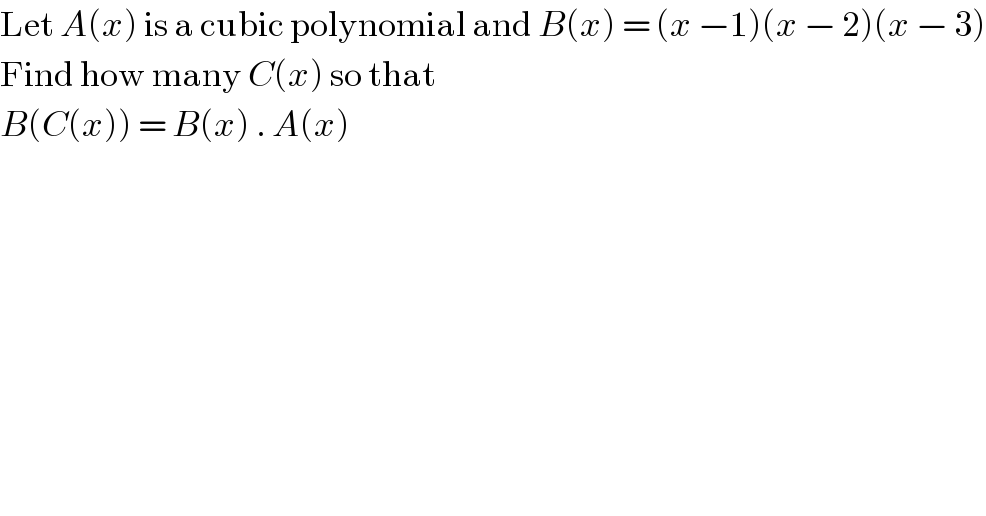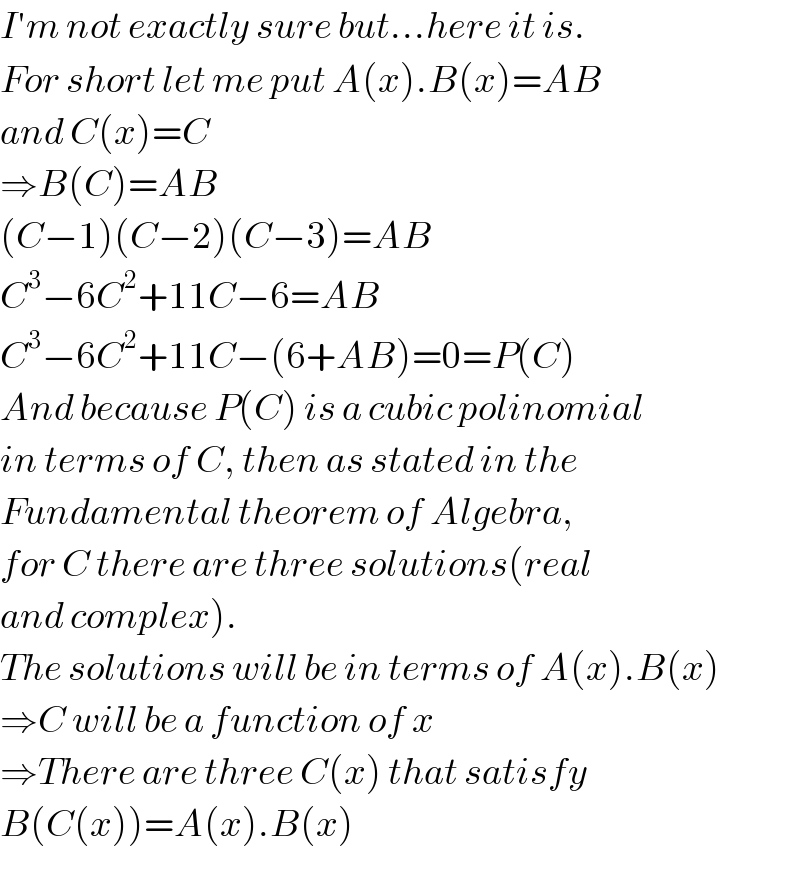
Question Number 21656 by Joel577 last updated on 30/Sep/17

$$\mathrm{Let}\:{A}\left({x}\right)\:\mathrm{is}\:\mathrm{a}\:\mathrm{cubic}\:\mathrm{polynomial}\:\mathrm{and}\:{B}\left({x}\right)\:=\:\left({x}\:−\mathrm{1}\right)\left({x}\:−\:\mathrm{2}\right)\left({x}\:−\:\mathrm{3}\right) \\ $$$$\mathrm{Find}\:\mathrm{how}\:\mathrm{many}\:{C}\left({x}\right)\:\mathrm{so}\:\mathrm{that} \\ $$$${B}\left({C}\left({x}\right)\right)\:=\:{B}\left({x}\right)\:.\:{A}\left({x}\right) \\ $$
Commented by Joel577 last updated on 01/Oct/17

$${The}\:{answer}\:{isn}'{t}\:{given}\:{to}\:{me}.\: \\ $$$${Pls}\:{explain},\:{Sir} \\ $$
Commented by alex041103 last updated on 30/Sep/17

$${Isn}'{t}\:{it}\:\mathrm{3}? \\ $$
Commented by alex041103 last updated on 01/Oct/17

$${I}'{m}\:{not}\:{exactly}\:{sure}\:{but}...{here}\:{it}\:{is}. \\ $$$${For}\:{short}\:{let}\:{me}\:{put}\:{A}\left({x}\right).{B}\left({x}\right)={AB} \\ $$$${and}\:{C}\left({x}\right)={C} \\ $$$$\Rightarrow{B}\left({C}\right)={AB} \\ $$$$\left({C}−\mathrm{1}\right)\left({C}−\mathrm{2}\right)\left({C}−\mathrm{3}\right)={AB} \\ $$$${C}^{\mathrm{3}} −\mathrm{6}{C}^{\mathrm{2}} +\mathrm{11}{C}−\mathrm{6}={AB} \\ $$$${C}^{\mathrm{3}} −\mathrm{6}{C}^{\mathrm{2}} +\mathrm{11}{C}−\left(\mathrm{6}+{AB}\right)=\mathrm{0}={P}\left({C}\right) \\ $$$${And}\:{because}\:{P}\left({C}\right)\:{is}\:{a}\:{cubic}\:{polinomial} \\ $$$${in}\:{terms}\:{of}\:{C},\:{then}\:{as}\:{stated}\:{in}\:{the} \\ $$$${Fundamental}\:{theorem}\:{of}\:{Algebra}, \\ $$$${for}\:{C}\:{there}\:{are}\:{three}\:{solutions}\left({real}\right. \\ $$$$\left.{and}\:{complex}\right). \\ $$$${The}\:{solutions}\:{will}\:{be}\:{in}\:{terms}\:{of}\:{A}\left({x}\right).{B}\left({x}\right) \\ $$$$\Rightarrow{C}\:{will}\:{be}\:{a}\:{function}\:{of}\:{x} \\ $$$$\Rightarrow{There}\:{are}\:{three}\:{C}\left({x}\right)\:{that}\:{satisfy} \\ $$$${B}\left({C}\left({x}\right)\right)={A}\left({x}\right).{B}\left({x}\right) \\ $$
Commented by Joel577 last updated on 01/Oct/17

$${but}\:{the}\:{options}\:{are} \\ $$$$\mathrm{19} \\ $$$$\mathrm{22} \\ $$$$\mathrm{24} \\ $$$$\mathrm{27} \\ $$$$\mathrm{32} \\ $$
